A Step-by-Step Guide to Performing an Ethiopian Coffee Ceremony
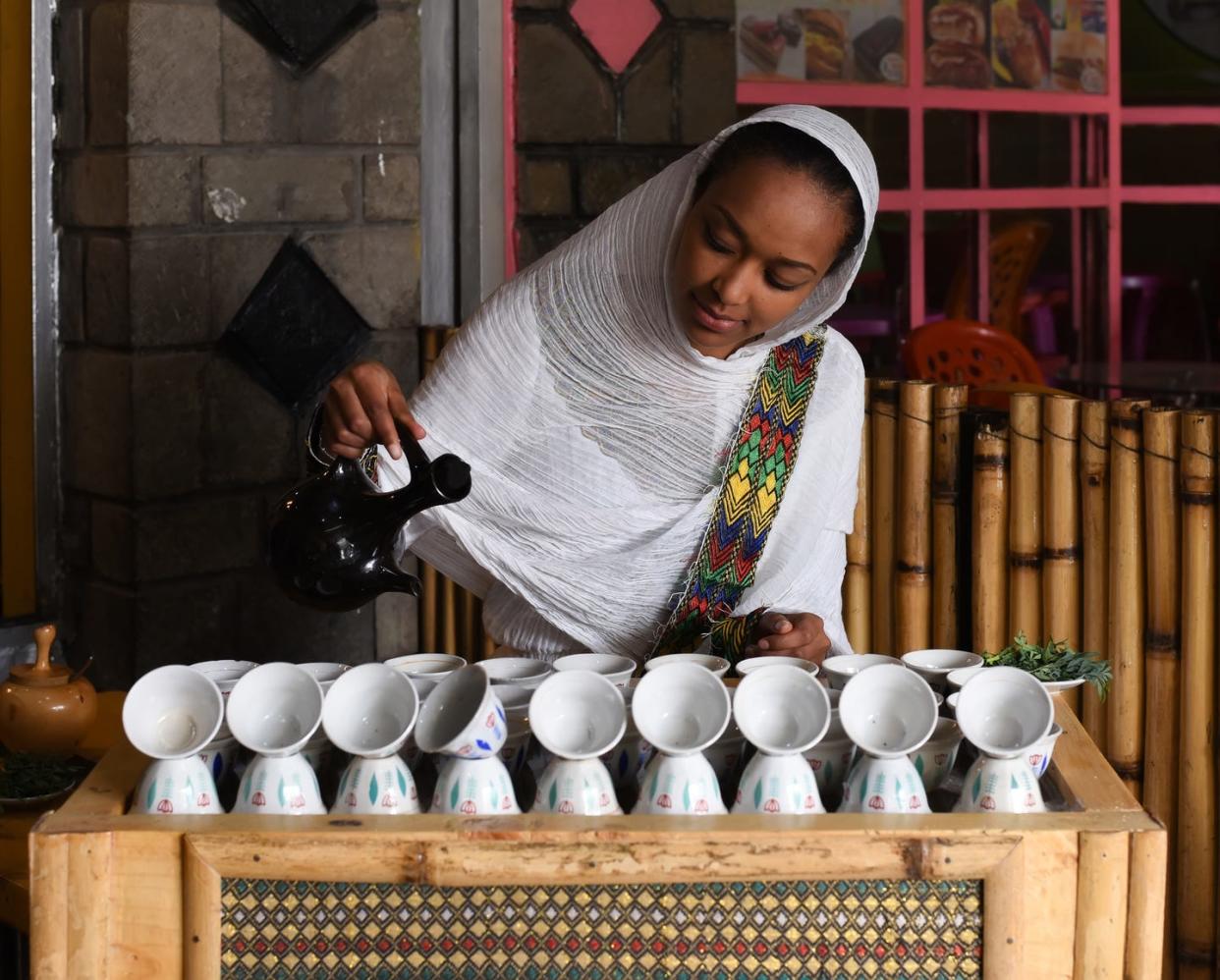
Ethiopia is known as the birthplace of coffee — the coffee plant, coffea arabica, is native to the country's southwestern plateaus. Coffee is also central to Ethiopia's culture and its economy. Beans grown in its fertile soil account for about 17% of the global coffee market and have long set the standard for quality coffee. If you've tasted the botanical-forward Yirgacheffe or the bright and earthy Sidamo, you've had Ethiopian coffee.
But the definition of Ethiopian coffee expands exponentially once beans are placed in a traditional Ethiopian vessel called a jebena. The distinctive clay pot is essential to the centuries-old Ethiopian coffee ceremony which promises social connection and the freshest cup of coffee you can make. But what is the ceremony all about? Tigist Reda, owner of the acclaimed Ethiopian restaurant, Demera, located in Chicago, helps explain, with photos from Ethiopian coffee ceremonies that she has hosted.
What is an Ethiopian coffee ceremony?
The daily practice of drinking coffee with family and friends is commonly called an Ethiopian coffee ceremony, particularly in the West, but “we call it ‘buna,’” says Reda, who grew up in Tigray, Ethiopia's northern region. The translation of “buna tetu” is to “come drink coffee with us,” underscoring the reverence given not only to coffee, but also to community.
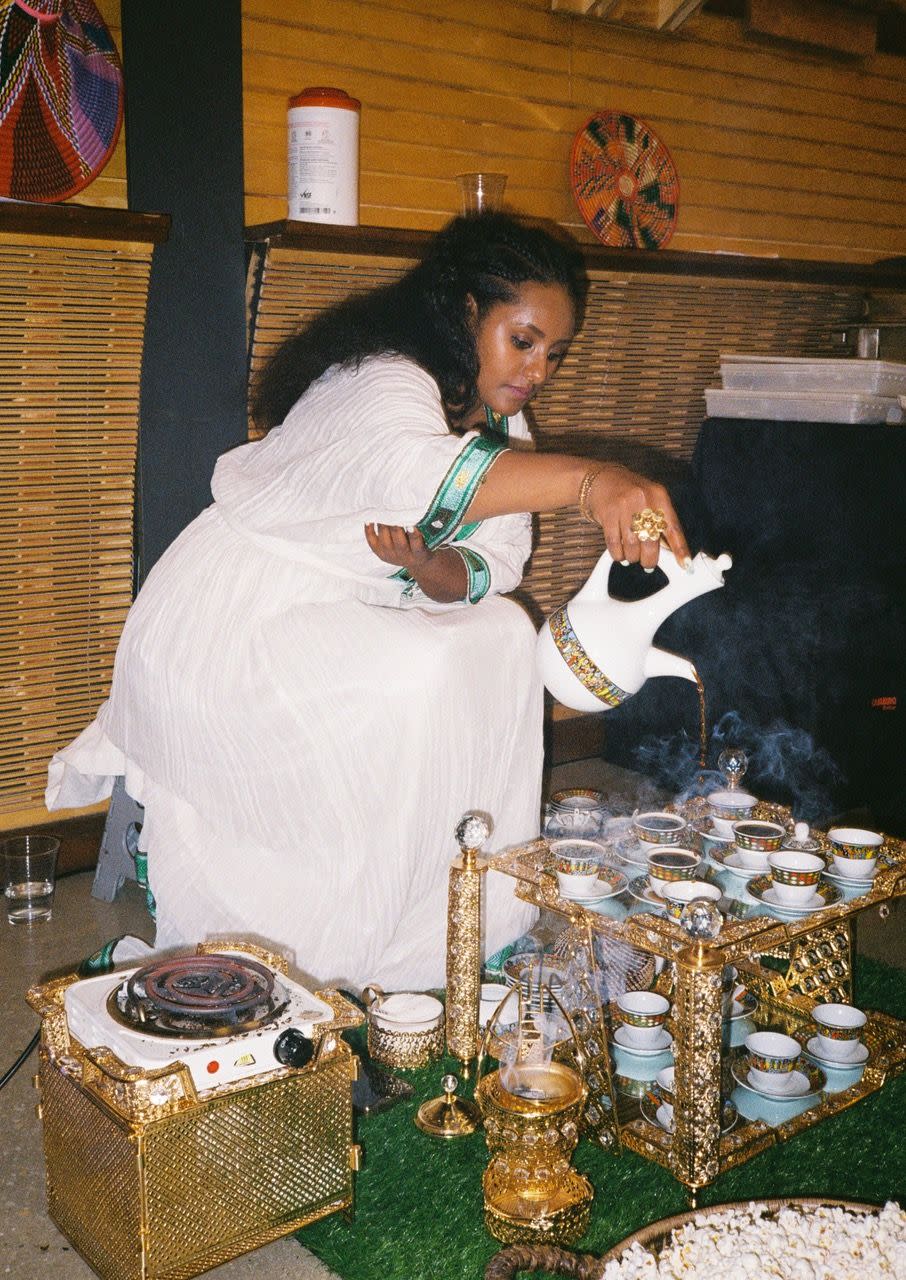
When Reda speaks of the coffee that she grew up on, she’s describing a daily coffee ritual that’s elaborate without being fussy. “It happens every day, so I don’t even know if our mothers call it ‘ceremonial.’ It’s not a special occasion for them, it’s a way to start their day.”
The traditional steps for an Ethiopian coffee ceremony
Step 1: Create the ambiance.
Preparing the outdoor area where buna typically occurs is akin to setting a table, but with coffee as the centerpiece. As stools are gathered around the host, she arranges layers of fragrance — from fresh grass and flowers to burning incense of frankincense or myrrh — for a multi-sensory experience that links land and people. Ethiopian coffee, similarly to its cuisine, offers much interplay with smell. “Part of our dining experience is aroma; like what does it smell like? It's not just what you eat or what you drink. It kind of wakes up your senses, something in your spirit,” says Reda.
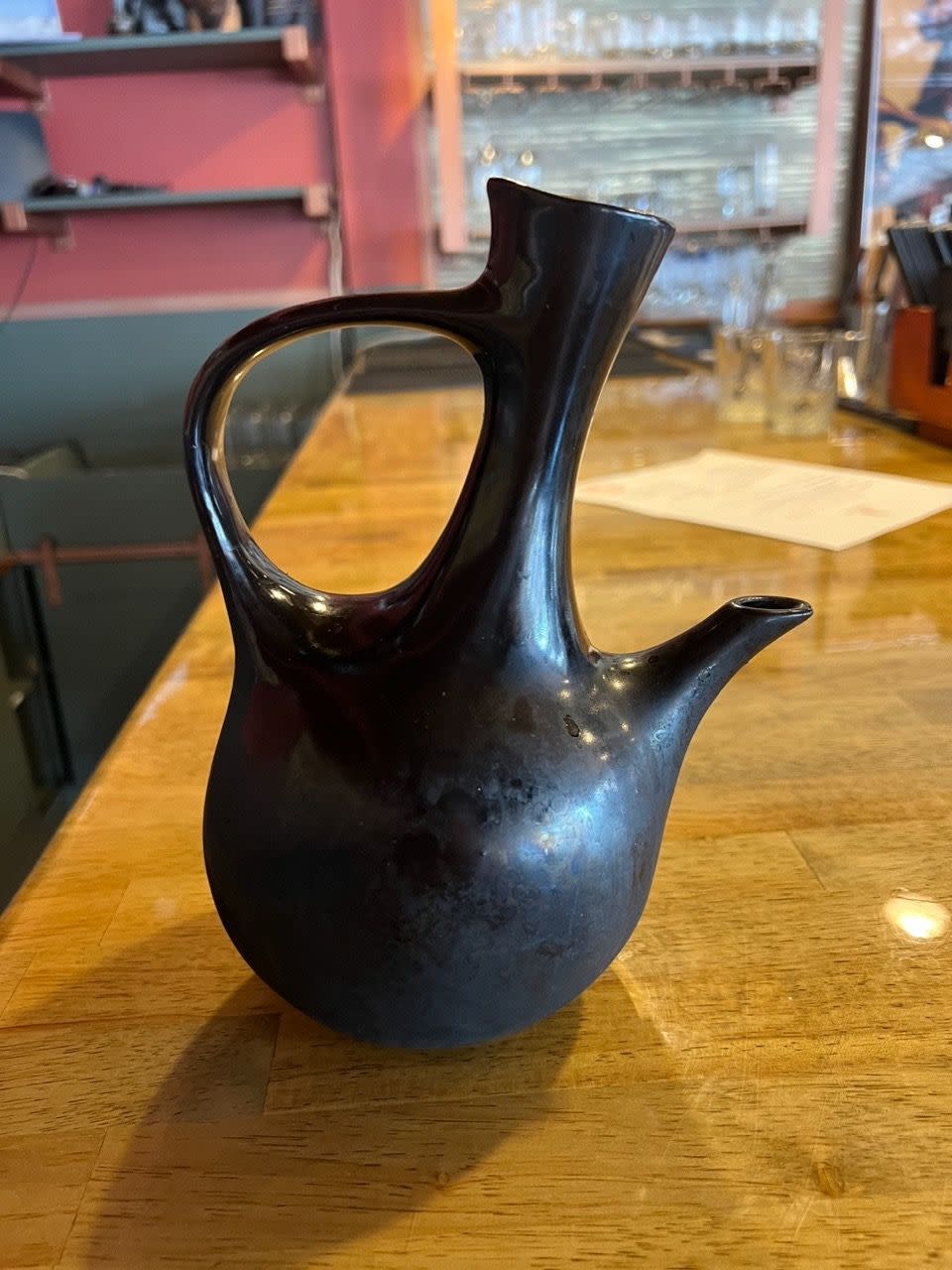
Reda roasts her green coffee beans of organic Yirgacheffe in the oven twice a week which offers plenty of inventory for the single pours of coffee that are offered on Demera’s standard menu, as well as the coffee for private events where buna may be served.
Note: While Reda has come across some jebenas made of ceramic and cups with handles, she prefers the classic way. Because the traditional jebena is made of decorative pottery, the vessel frequently cracks and is not usually passed down from generation to generation, but is often replaced. “The first time you use it you have to treat it so it can seal. You put it over heat, and then you turn it around, you let it cook, and then you can put sugar or coffee or something to seal," she says.
Step 2: Roast and grind the coffee beans.
Green coffee beans are the raw seed that’s been removed from the coffee cherry. The beans are washed several times then poured onto a hot pan over a heat source, like charcoal, and roasted until they take on a shade of deep ebony that resembles the beans that most are accustomed to. At Demera, buna is only served during private events where multiple jebenas are going at once to serve large crowds.
The beans are then ground by hand with a mortar and pestle into granules smaller than what a typical coffee grinder would produce, but not quite as fine as espresso. As the coffee is ground, the water boils in the jebena. Once the ground coffee is added, it simmers for a few minutes before serving. “There’s no filter because you’re just putting the water on top of the grounds, and then you let it settle,” Reda says.
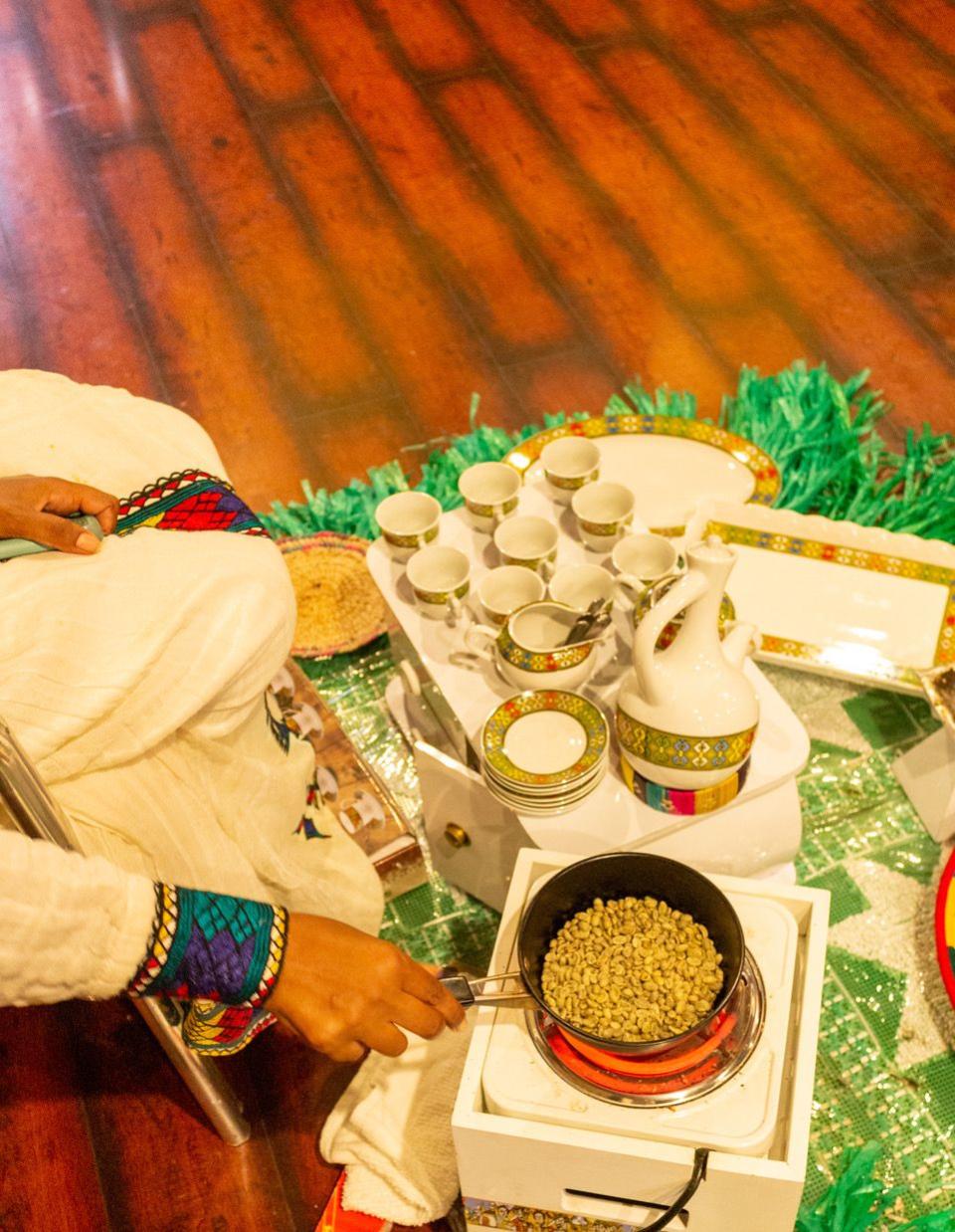
Step 3: Pause.
Let it settle — that’s an edict for the coffee as much as for the people. If one has the privilege to participate in buna, patience is required since the course can take up to two hours to complete. Plan ahead by blocking off the necessary time and try to stay present. Buna is the antithesis of a mobile order pickup.
Step 4: Chat with those around you.
Engaging in conversation with the purpose of connecting with the greater community is a tenant of buna. Reda recalls the wafts of roasted coffee being an open invitation. “Your neighbors might come in, or if you move into a new neighborhood, you invite people over for buna and they invite you to get to know each other,” she says. Coffee is meant to be sipped slowly while absorbing the sights, smells, and sounds, making for a type of theater that beckons audience participation. With the virtues of hospitality in full effect, conversation should flow with ease.
Step 5: Have some snacks.
As the coffee roasts, staple bites such as plain popcorn, well-seasoned roasted barley that’s been mixed with chickpeas called kolo, injera and other savory items are served in a manner that mirrors the communal aspects of Ethiopian cuisine. The snacks are intended to both help keep up the rhythm of conversation over time and pad the stomach for the powerful cup(s) ahead. “You can almost call it dining where you’re having conversation and things are being served,” says Reda.
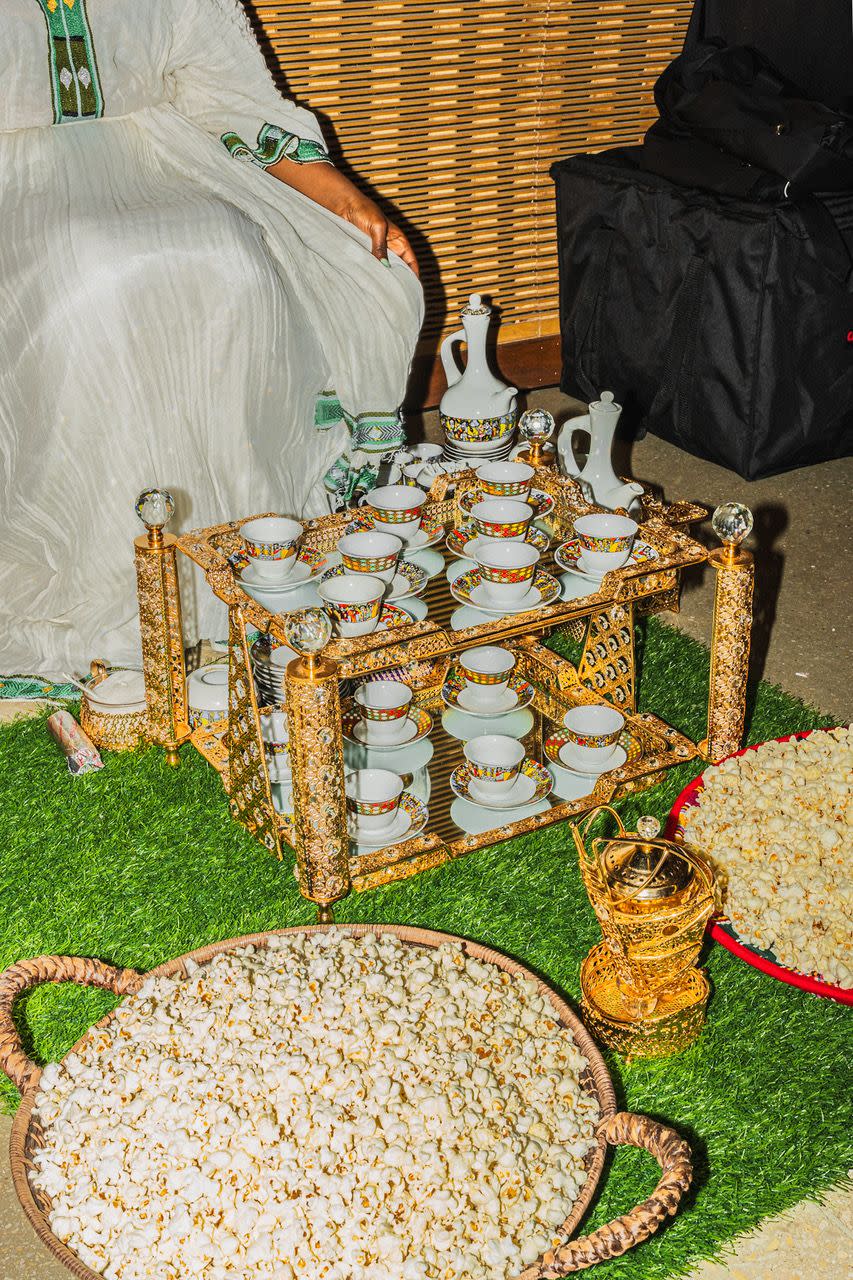
Step 6: Feel free to have another cup.
Buna occurs multiple times throughout the day. While the host prepares the ambiance just as before, she only roasts the coffee beans once. After the first pour, the jebena can be refilled twice more. As the day goes on, the pot is kept filled with its original coffee grounds, and a total of three cups of coffee, traditionally called abol, bereka and tona, with each getting weaker than the previous one.
Once the host pours the coffee into small, hand-painted ceramic cups there’s a cool-down period. Cups are traditionally handless, and Reda advises holding the cups from the edge to avoid getting burned.
Things to keep in mind
Honor elders. Etiquette largely comes into play during serving, which prioritizes elders. “Serve with your two hands, not one hand; get up for older people – and it's like total respect for your elder, so you serve the elder first.”
Coffee is usually enjoyed black. Regionality seems to dictate what is or isn’t added to coffee. While most enjoy their cup of black coffee, some add sugar or ghee. Others add spices, such as whole cloves, to the coffee beans as they roast. “You put just one clove and when you roast it you have this aroma. Like you don’t taste the clove right up front because you just put one piece, but you kind of taste it in the back,” says Reda.
Look for buna locally. If you're interested in participating in a traditional Ethiopian coffee service, reach out to an Ethiopian restaurant or cafe in your area to see if buna is offered.
You Might Also Like


